transmission fluid CHEVROLET SUBURBAN 1994 Owners Manual
[x] Cancel search | Manufacturer: CHEVROLET, Model Year: 1994, Model line: SUBURBAN, Model: CHEVROLET SUBURBAN 1994Pages: 385, PDF Size: 19.88 MB
Page 189 of 385
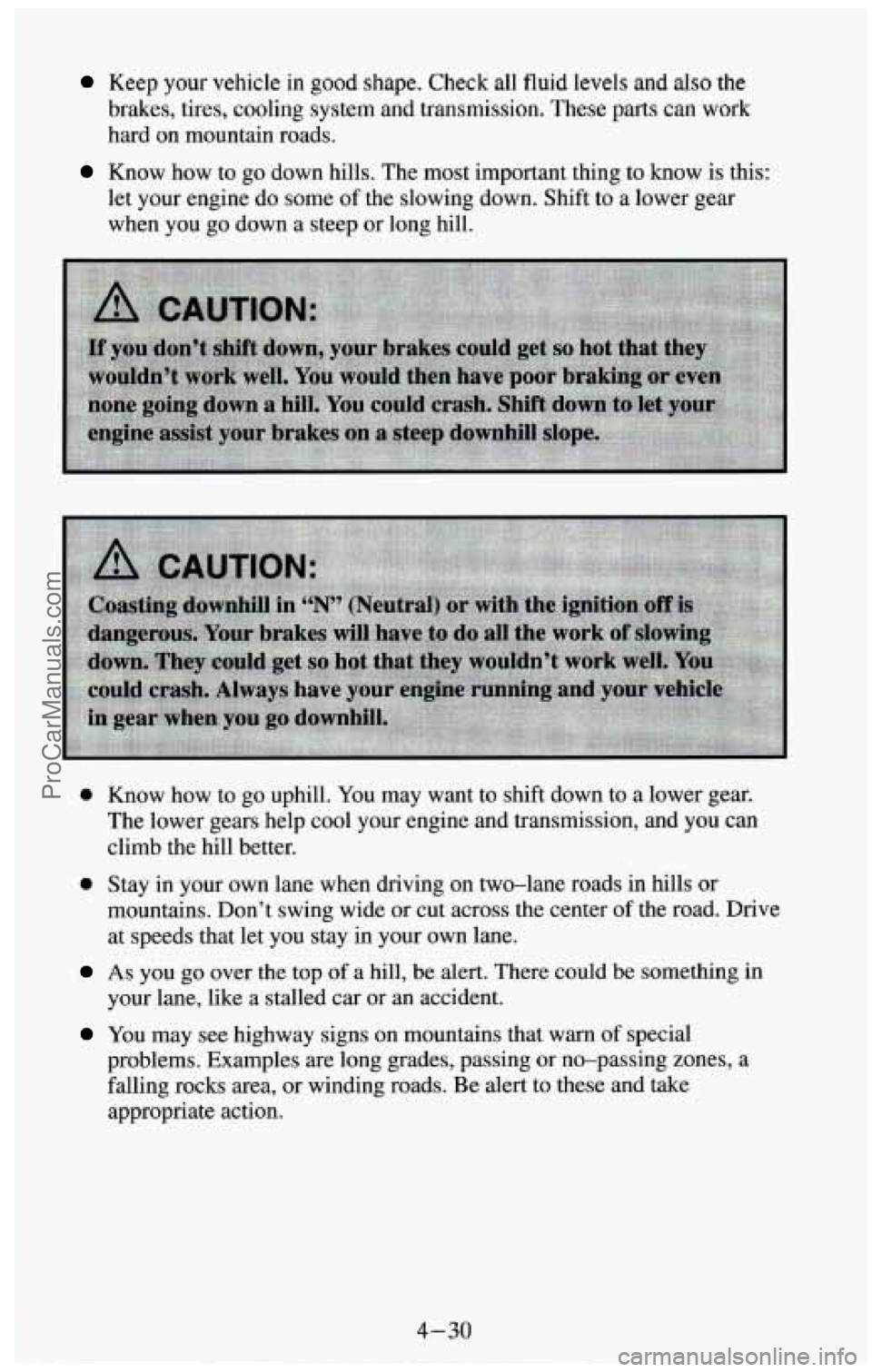
Keep your vehicle in good shape. Check all fluid levels and also the
brakes, tires, cooling system and transmission. These parts can work
hard on mountain roads.
Know how to go down hills. The most important thing to know is this:
let your engine do some
of the slowing down. Shift to a lower gear
when you go down
a steep or long hill.
0 Know how to go uphill. You may want to shift down to a lower gear.
The lower gears help cool your engine and transmission, and you can
climb the hill better.
0 Stay in your own lane when driving on two-lane roads in hills or
mountains. Don’t swing wide or cut across the center of the road. Drive
at speeds that let you stay in your own lane.
As you go over the top of a hill, be alert. There could be something in
your lane, like
a stalled car or an accident.
You may see highway signs on mountains that warn of special
problems. Examples are long grades, passing or no-passing zones, a
falling rocks area, or winding roads. Be alert to these and take
appropriate action.
4-30
i ProCarManuals.com
Page 203 of 385
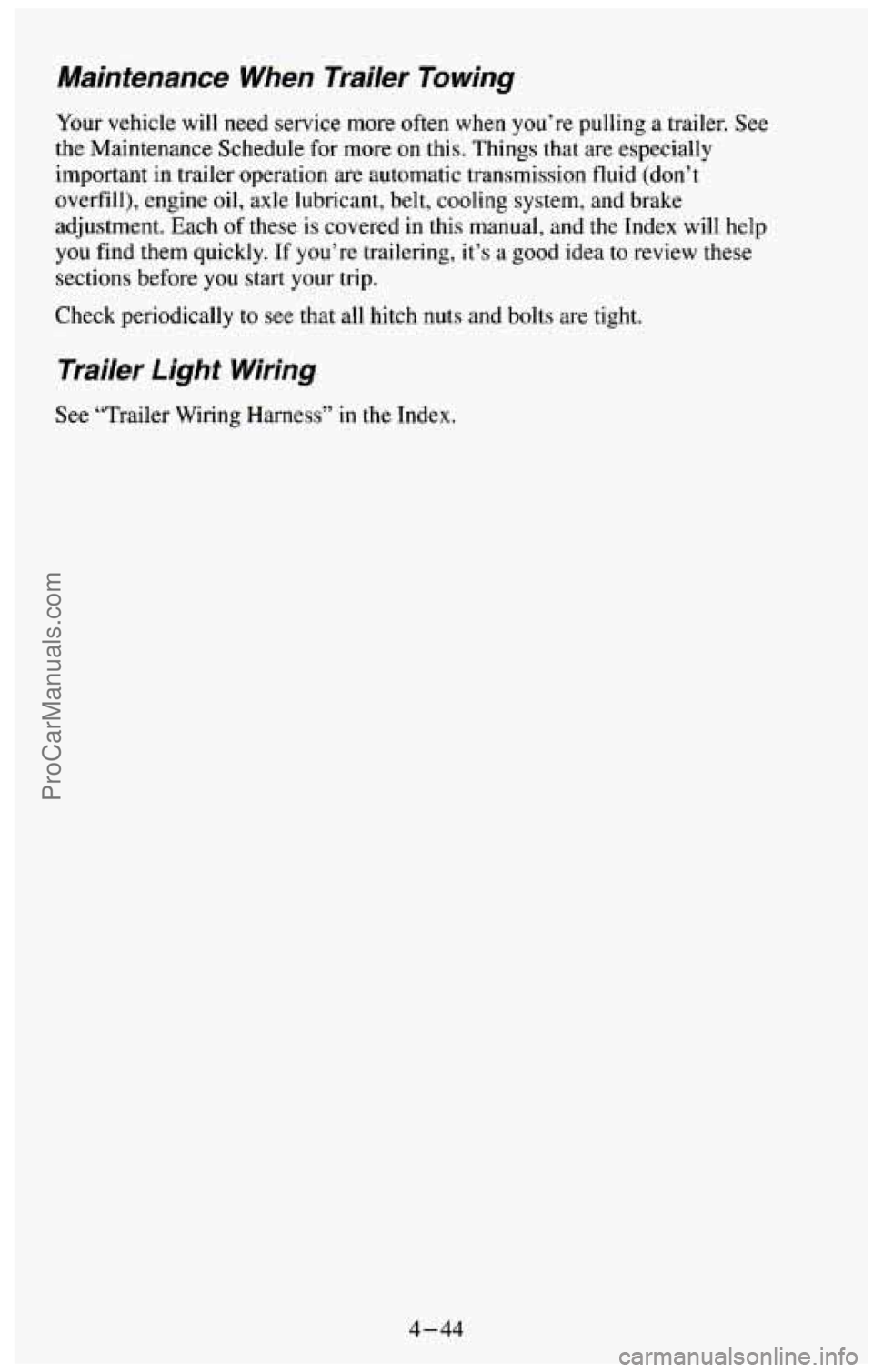
Maintenance When Trailer Towing
Your vehicle will need service more often when you’re pulling a trailer. See
the Maintenance Schedule for more on this. Things that are especially
important in trailer operation are automatic transmission fluid (don’t
overfill), engine oil, axle lubricant, belt, cooling system, and brake
adjustment. Each
of these is covered in this manual, and the Index will help
you find them quickly. If you’re trailering, it’s a good idea to review these
sections before you start your trip.
Check periodically to see
that all hitch nuts and bolts are tight.
Trailer Light Wiring
See “Trailer Wiring Harness” in the Index.
4-44
ProCarManuals.com
Page 246 of 385
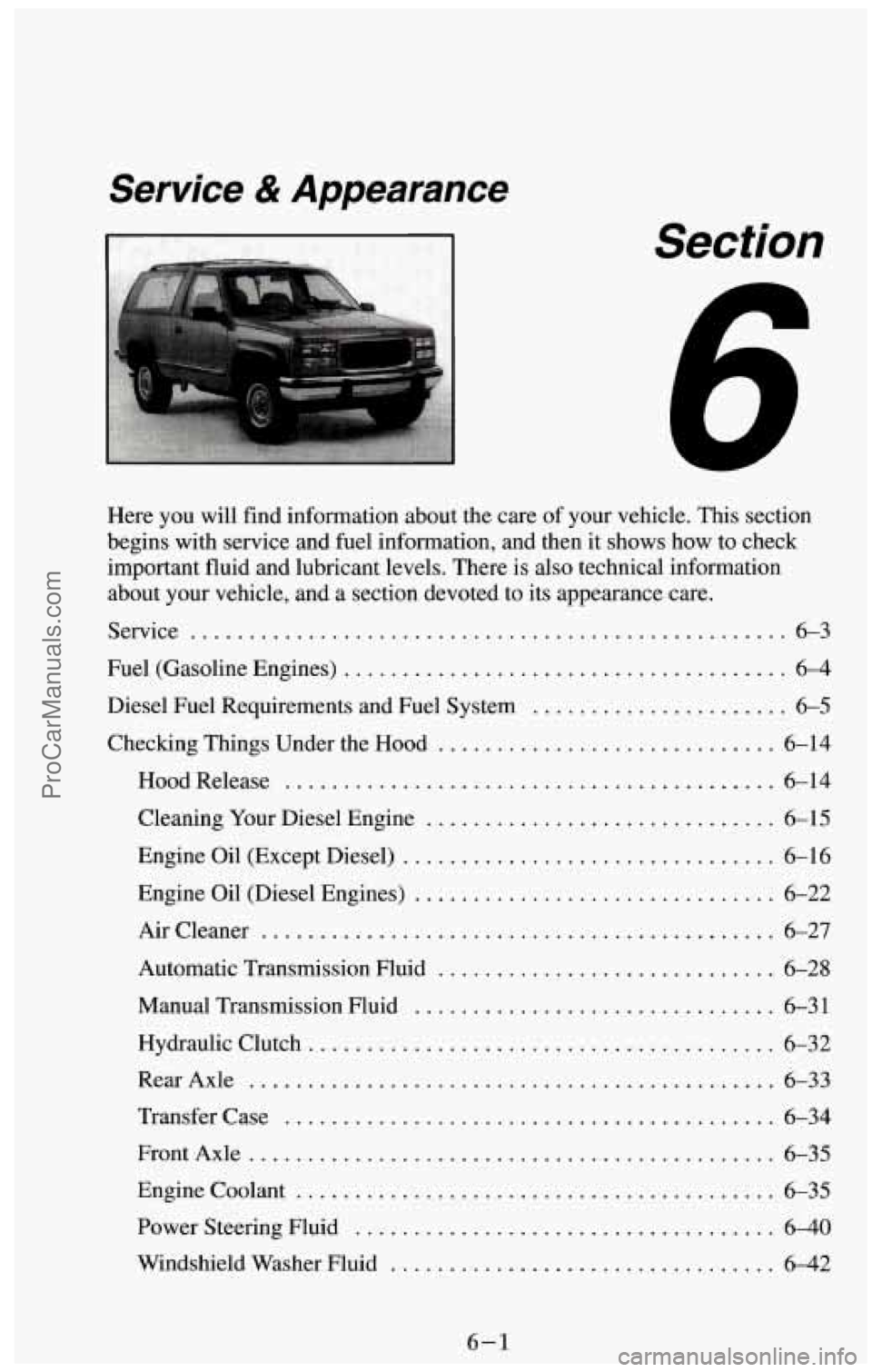
Service & Appearance
I Section
Here you will find information about the care of your vehicle . This section
begins with service and fuel information. and then it shows how to check
important fluid and lubricant levels
. There is also technical information
about your vehicle. and a section devoted to its appearance care
.
Service ................................................... 6-3
Fuel (Gasoline Engines)
............................
Diesel Fuel Requirements and Fuel System ..........
Checking Things Under the Hood ........... .....
........ 6-4
.......... 6-5
......... 6-14
HoodRelease
.......................................... 6-14
Cleaning Your Diesel Engine
............................ 6-15
Engine Oil (Except Diesel)
................................ 6-16
Engine Oil (Diesel Engines)
............................... 6-22
Aircleaner
.................... .................. 6-27 ..
Automatic Transmission Fluid ............................. 6-28
Manual Transmission Fluid
............................... 6-31
Hydraulic Clutch
........................................ 6-32
RearAxle
............................................. 6-33
Transfer Case
.......................................... 6-34
FrontAxle
........................................... 6-35
Engine Coolant
......................................... 6-35
Power Steering Fluid
.............. .................. 640
Windshield Washer Fluid
............................... 6-42
6-1
ProCarManuals.com
Page 273 of 385
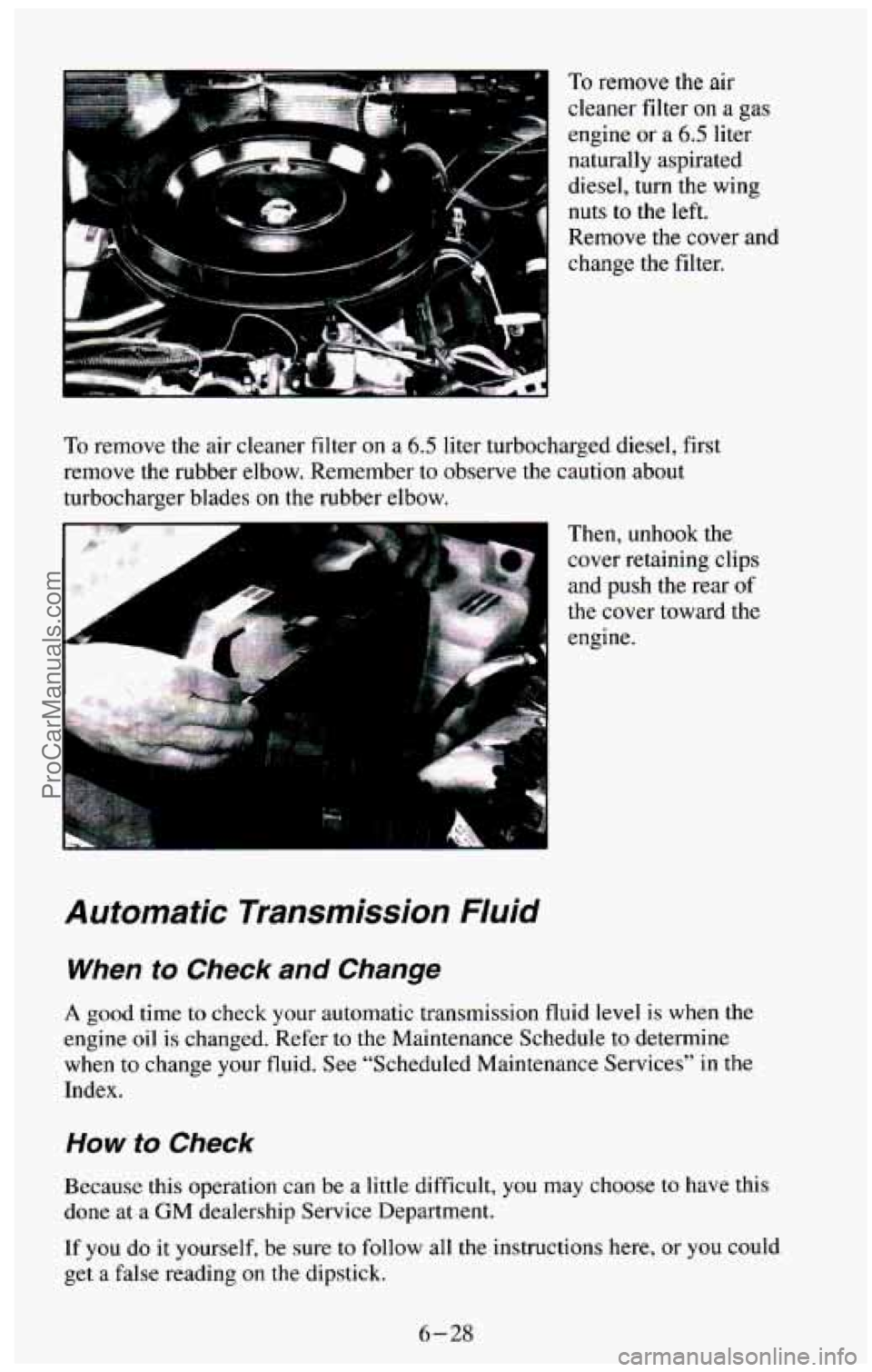
To remove the air
cleaner filter
on a gas
engine or
a 6.5 liter
naturally aspirated
diesel, turn the wing
nuts
to the left.
Remove the cover and
change the filter.
To remove the air cleaner filter on a 6.5 liter turbocharged diesel, first
remove the rubber elbow. Remember to observe the caution about
turbocharger blades on the rubber elbow,
Then, unhook the
cover retaining clips
and push the rear
of
the cover toward the
engine.
Automatic Transmission Fluid
When to Check and Change
A good time to check your automatic transmission fluid level is when the
engine
oil is changed. Refer to the Maintenance Schedule to determine
when to change your fluid.
See “Scheduled Maintenance Services” in the
Index.
How to Check
Because this operation can be a little difficult, you may choose to have this
done at a
GM dealership Service Department.
If you do it yourself, be sure to follow all the instructions here, or you could
get
a false reading on the dipstick.
6-28
ProCarManuals.com
Page 274 of 385
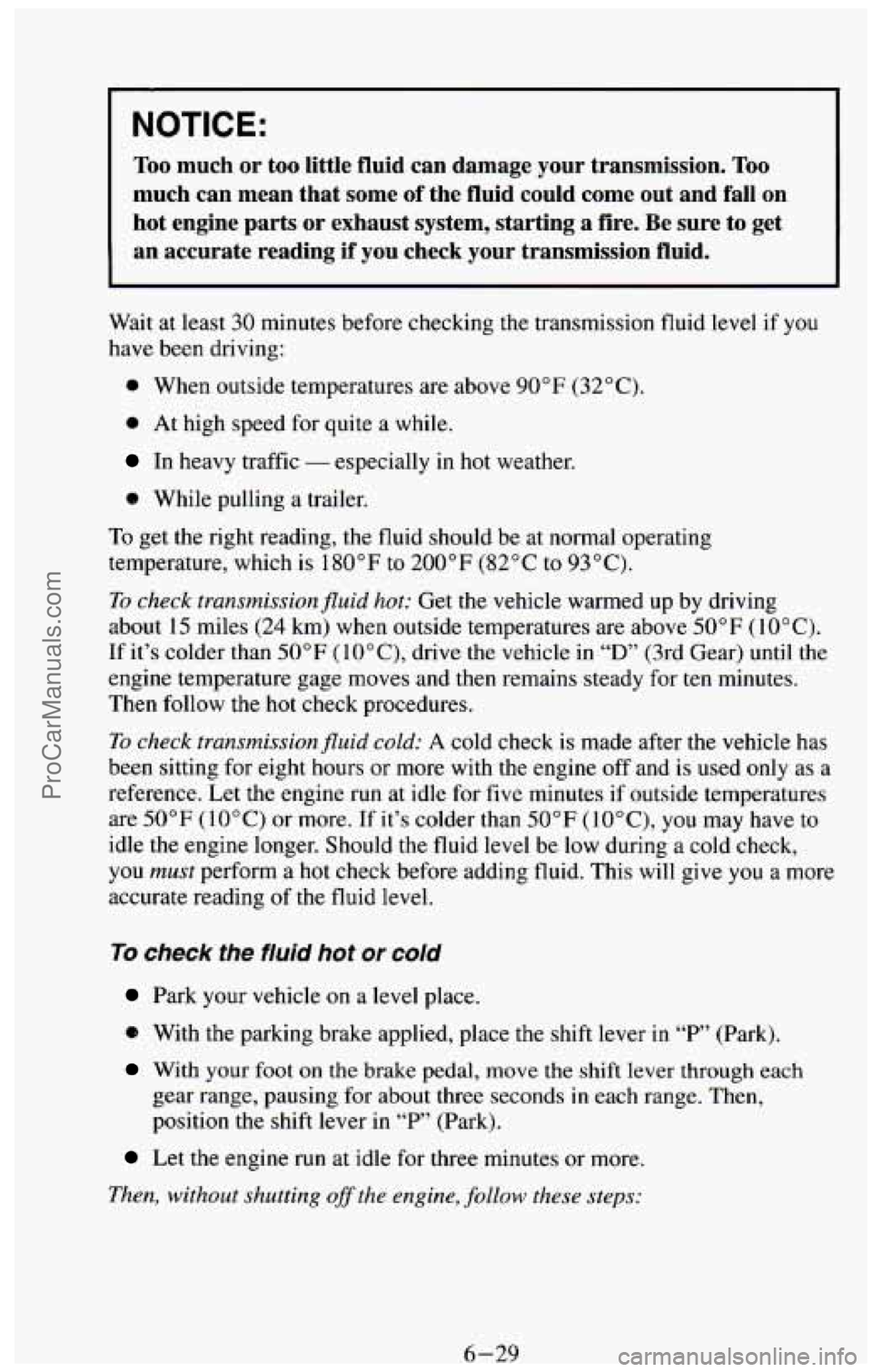
NOTICE:
Too much or too little fluid can damage your transmission. Too
much can mean that some of the fluid could come out and fall on
hot engine parts or exhaust system, starting a fire. Be sure to get
an accurate reading if you check your transmission fluid.
Wait at least 30 minutes before checking the transmission fluid level if you
have been driving:
0 When outside temperatures are above 90°F (32°C).
0 At high speed for quite a while.
In heavy traffic - especially in hot weather.
0 While pulling a trailer.
To get the right reading, the fluid should be at normal operating
temperature,
which is 180°F to 200°F (82°C to 93°C).
To check transmissionfluid hot: Get the vehicle warmed up by driving
about 15 miles
(24 km) when outside temperatures are above 50°F (IOOC).
If it’s colder than 50°F (IOOC), drive the vehicle in “D” (3rd Gear) until the
engine temperature gage moves and then remains steady for
ten minutes.
Then follow
the hot check procedures.
To check transmissionfluid cold: A cold check is made after the vehicle has
been sitting for eight hours or more with the engine off and
is used only as a
reference. Let the engine run at idle for five minutes if outside temperatures
are
50°F (10°C) or more. If it’s colder than 50°F (IOOC), you may have to
idle the engine longer. Should
the fluid level be low during a cold check,
you
must perform a hot check before adding fluid. This will give you a more
accurate reading of the fluid level.
To check the fluid hot or cold
Park your vehicle on a level place.
e With the parking brake applied, place the shift lever in “P’ (Park).
With your foot on the brake pedal, move the shift lever through each
gear range, pausing for about three seconds in each range. Then,
position the shift lever in
“P” (Park).
Let the engine run at idle for three minutes or more.
Then, without shutting off the engine, follow these steps:
6-29 ProCarManuals.com
Page 276 of 385

WOW to Add Fluid
Refer to the Maintenance Schedule to determine what kind of transmission
fluid to use. See “Recommended Fluids and Lubricants’’ in the Index.
If the fluid level
is low, add only enough of the proper fluid to bring the
level up to the
COLD area for a cold check or the HOT area for a hot check.
It doesn’t take much fluid, generally
less than a pint. Don’t overfill. We
recommend you use
only fluid labeled DEXRON@-I11 or DEXRON@-IIE,
because fluids with that label are made especially for your automatic
transmission. Damage caused
by fluid other than DEXRON@-I11 or
DEXRON@-IIE is not covered
by your new vehicle warranty.
After adding fluid, recheck the fluid level as described under “How to
Check.”
When the correct fluid level is obtained, push the dipstick back in all
the way; then flip the handle down to lock the dipstick
in place.
Manual Transmission Fluid
When to Check
A good time to have it checked is when the engine oil is changed. However,
the fluid
in your manual transmission doesn’t require changing.
How to Check
Because this operation can be a little difficult, you may choose to have this
done at a
GM dealership Service Department.
If you do it yourself, be sure to follow all the instructions here, or you could
get
a false reading.
NOTICE:
Too much or too little fluid can damage your transmission. Too
much can mean that some of the fluid could come out and fall on
hot engine parts or exhaust system, starting a fire. Be sure to get
an accurate reading if
you check your transmission fluid.
Check the fluid level only when your engine is off, the vehicle is parked on
a level place and the transmission is cool enough for you to rest your fingers
on the transmission case.
6-31 ProCarManuals.com
Page 351 of 385
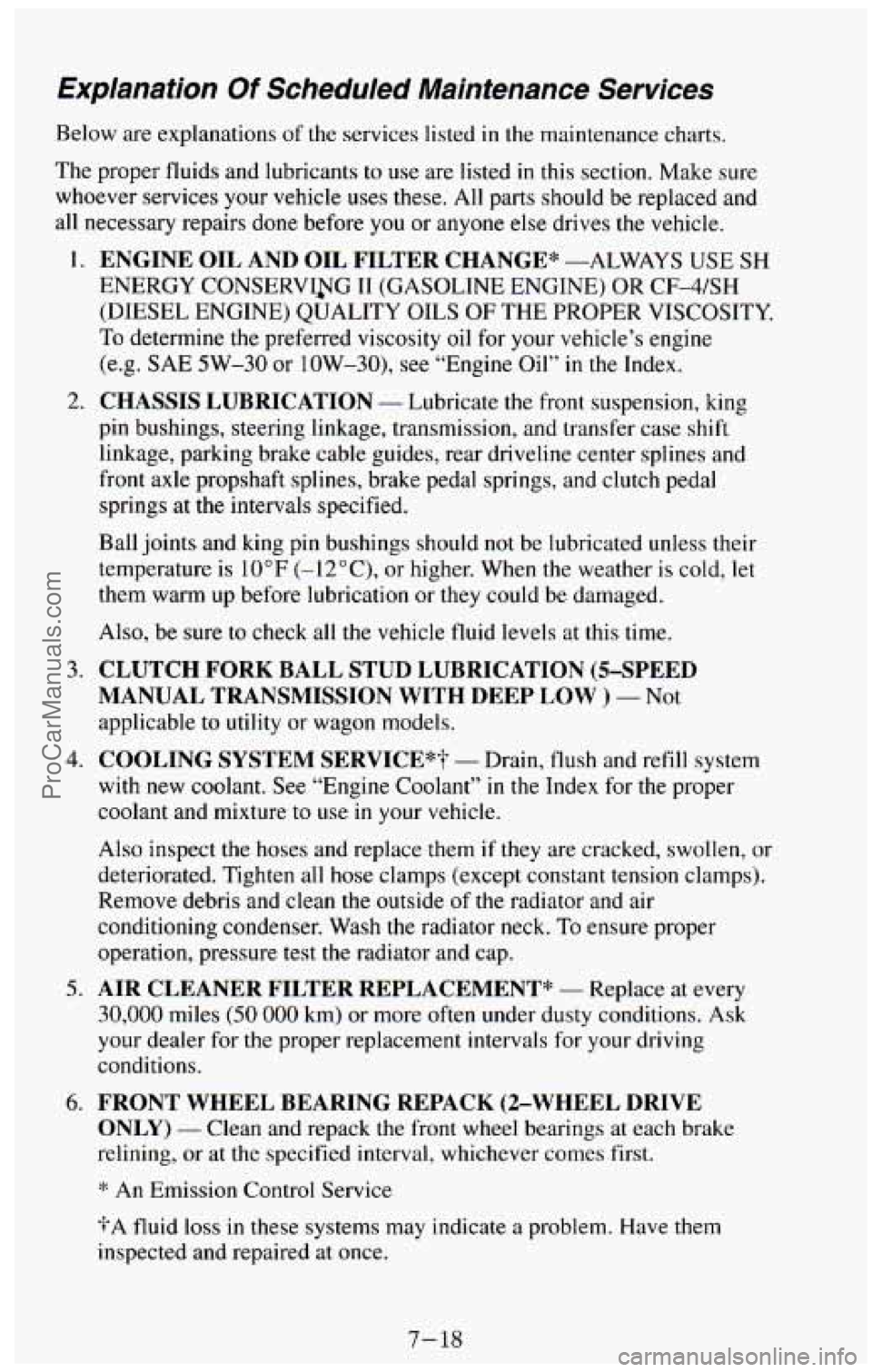
Explanation Of Scheduled Maintenance Services
Below are explanations of the services listed in the maintenance charts.
The proper fluids and lubricants to
use are listed in this section. Make sure
whoever services your vehicle uses these.
All parts should be replaced and
all necessary repairs done before you or anyone else drives the vehicle.
1. ENGINE OIL AND OIL FILTER CHANGE* -ALWAYS USE SH
ENERGY CONSERVIJTG TI (GASOLINE ENGINE) OR CF-4/SH
(DIESEL ENGINE) QUALITY OILS OF THE PROPER VISCOSITY.
To determine the preferred viscosity oil for your vehicle’s engine
(e.g.
SAE 5W-30 or low-30), see “Engine Oil” in the Index.
2. CHASSIS LUBRICATION - Lubricate the front suspension, king
pin bushings, steering linkage, transmission, and transfer case shift
linkage, parking brake cable guides, rear driveline center splines and
front axle propshaft splines, brake pedal springs, and clutch pedal
springs at the intervals specified.
Ball joints and king pin bushings should not be lubricated unless their
temperature is
10°F (-12”C), or higher. When the weather is cold, let
them warm up before lubrication or they could be damaged.
Also, be sure to check all the vehicle fluid levels at this time.
3. CLUTCH FORK BALL STUD LUBRICATION (5-SPEED
MANUAL TRANSMISSION
WITH DEEP LOW ) - Not
applicable to utility or wagon models.
4. COOLING SYSTEM SERVICE*? - Drain, flush and refill system
with new coolant. See “Engine Coolant’’
in the Index for the proper
coolant and mixture to use
in your vehicle.
Also inspect the hoses and replace them
if they are cracked, swollen, or
deteriorated. Tighten all
hose clamps (except constant tension clamps).
Remove debris and clean
the outside of the radiator and air
conditioning condenser. Wash the radiator
neck. To ensure proper
operation, pressure test the radiator and cap.
5. AIR CLEANER FILTER REPLACEMENT* - Replace at every
30,000 miles (50 000 km) or more often under dusty conditions. Ask
your dealer for the proper replacement intervals
for your driving
conditions.
6. FRONT WHEEL BEARING REPACK (2-WHEEL DRIVE
ONLY)
- Clean and repack the front wheel bearings at each brake
relining, or at the specified interval, whichever comes first.
4’ An Emission Control Service
*A fluid loss in these systems may indicate a problem. Have them
inspected and repaired at once.
7- 18
ProCarManuals.com
Page 352 of 385
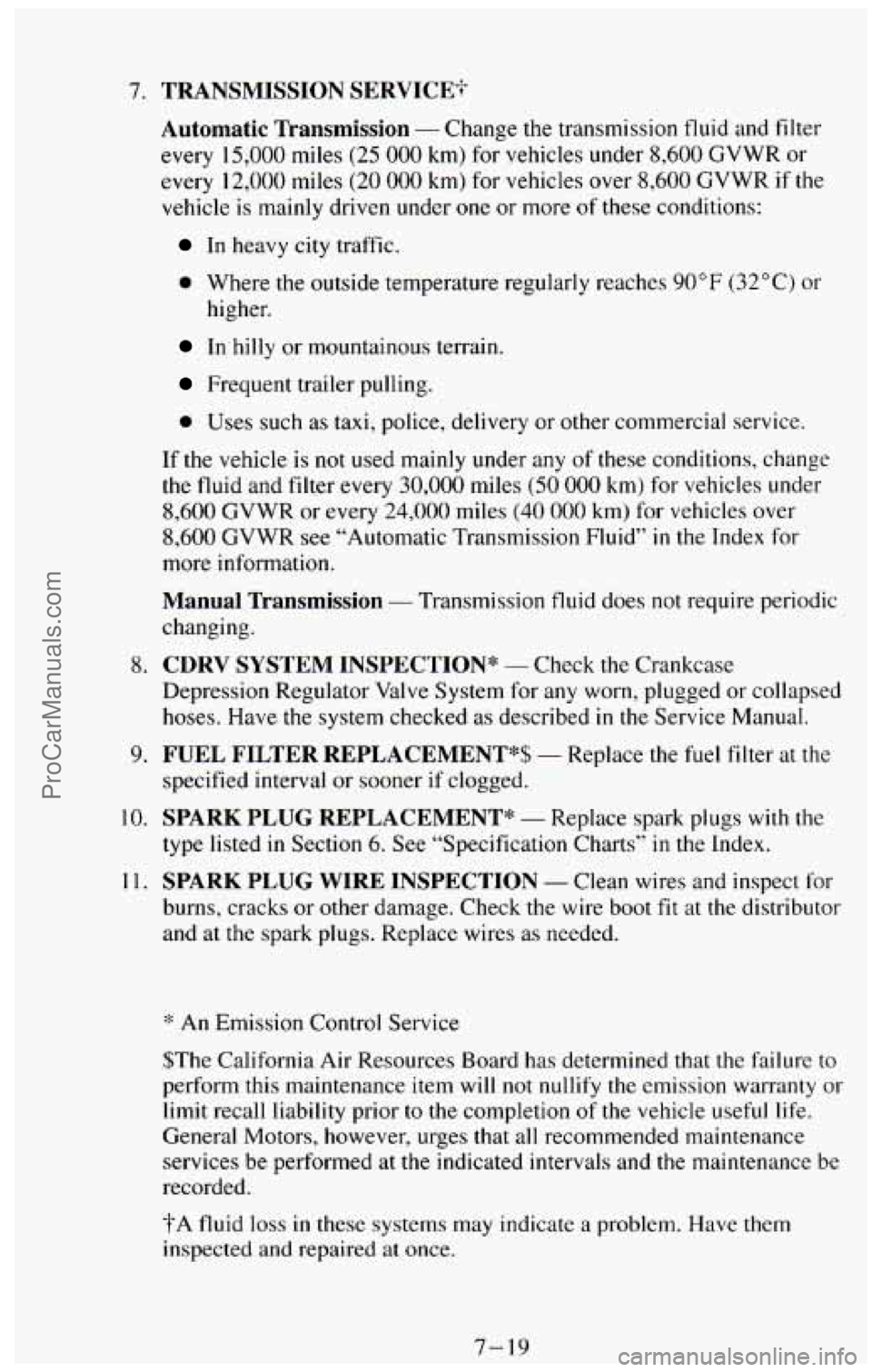
7. TRANSMISSION SERVICE;-
Automatic Transmission
- Change the transmission fluid and filter
every 15,000 miles
(25 000 km) for vehicles under 8,600 GVWR or
every 12,000 miles
(20 000 km) for vehicles over 8,600 GVWR if the
vehicle
is mainly driven under one or more of these conditions:
In heavy city traffic.
0 Where the outside temperature regularly reaches 90°F (32°C) or
higher.
In hilly or mountainous terrain.
Frequent trailer pulling.
0 Uses such as taxi, police, delivery or other commercial service.
If the vehicle is not used mainly under any
of these conditions, change
the fluid and filter every
30,000 miles (50 000 km) for vehicles under
8,600 GVWR or every 24,000 miles (40 000 km) for vehicles over
8,600 GVWR see “Automatic Transmission Fluid” in the Index for
more information.
Manual Transmission - Transmission fluid does not require periodic
changing.
8. CDRV SYSTEM INSPECTION* - Check the Crankcase
Depression Regulator Valve System for
any worn, plugged or collapsed
hoses. Have the system checked as described in the Service Manual.
9. FUEL FILTER REPLACEMENT*$ - Replace the fuel filter at the
specified interval or sooner if clogged.
10. SPARK PLUG REPLACEMENT* - Replace spark plugs with the
type listed in Section
6. See “Specification Charts” in the Index.
1 1. SPARK PLUG WIRE INSPECTION - Clean wires and inspect for
burns, cracks or other damage. Check the wire boot fit at the distributor
and at the
spark plugs. Replace wires as needed.
‘% An Emission Control Service
$The California Air Resources Board has determined that the failure to
perform this maintenance item will
not nullify the emission warranty or
limit recall liability prior to the completion of the vehicle useful life.
General Motors, however, urges that all recommended maintenance
services be performed at the indicated intervals and the maintenance be
recorded.
?A fluid loss in
these systems may indicate a problem. Have them
inspected and repaired at once.
7-19 ProCarManuals.com
Page 355 of 385
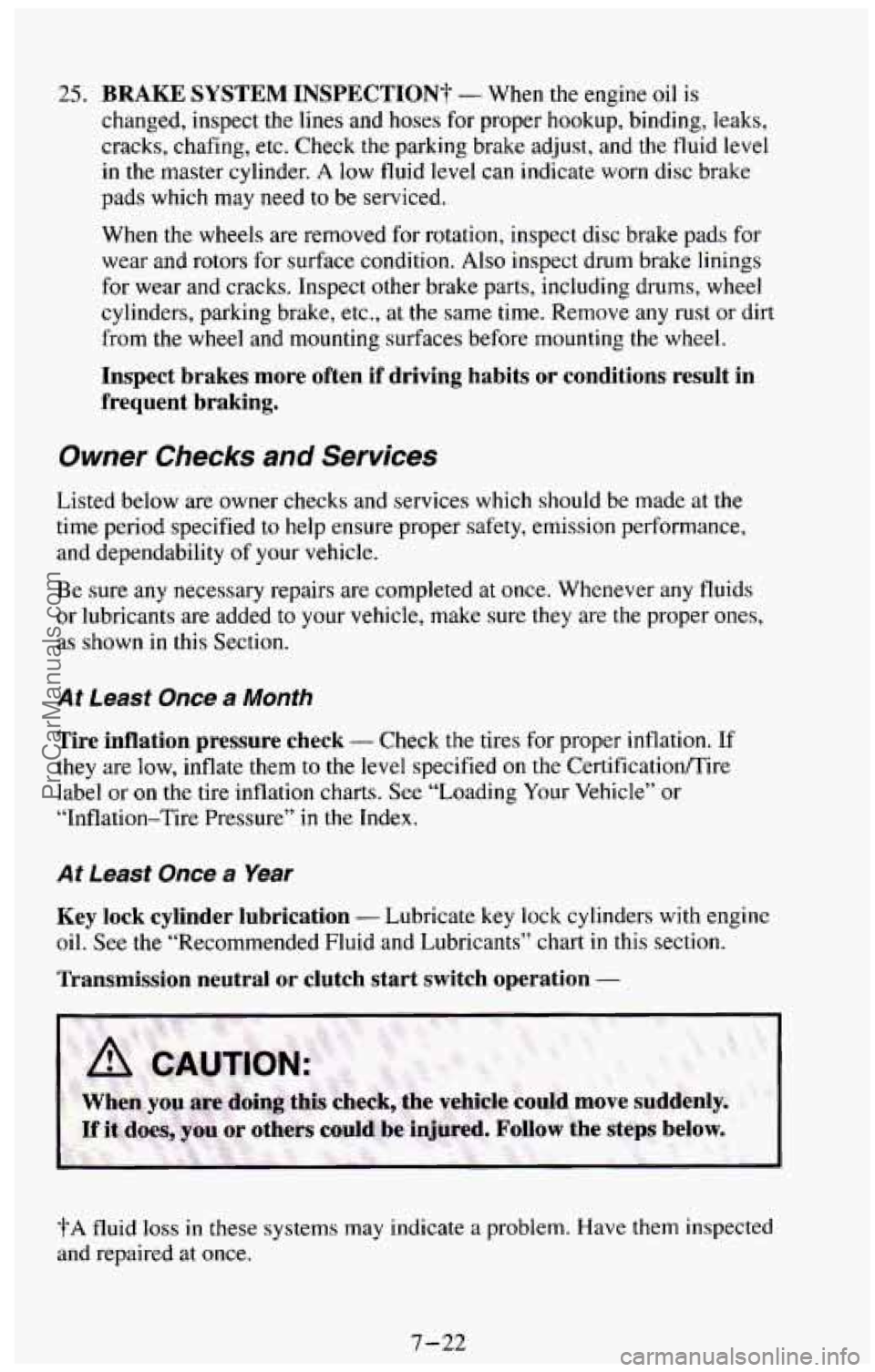
25. BRAKE SYSTEM INSPECTION? - When the engine oil is
changed, inspect the
lines and hoses for proper hookup, binding, leaks,
cracks, chafing, etc. Check
the parking brake adjust, and the fluid level
in the master cylinder.
A low fluid level can indicate worn disc brake
pads which may need to be serviced.
When the wheels are removed for rotation, inspect disc brake pads for
wear and rotors for surface condition. Also inspect drum brake linings
for wear and cracks. Inspect other brake parts, including drums, wheel
cylinders, parking brake, etc., at
the same time. Remove any rust or dirt
from the wheel and mounting surfaces before mounting
the wheel.
Inspect brakes more often if driving habits or conditions resul\
t in
frequent braking.
Owner Checks and Services
Listed below are owner checks and services which should be made at the
time period specified to help ensure proper safety, emission performance,
and dependability of your vehicle.
Be
sure any necessary repairs are completed at once. Whenever any fluids
or lubricants
are added to your vehicle, make sure they are the proper ones,
as shown in this Section.
At Least Once a Month
Tire inflation pressure check - Check the tires for proper inflation. If
they are low, inflate them to the level specified on the Certificatiomire
label or on the tire inflation charts. See “Loading Your Vehicle” or
“Inflation-Tire Pressure”
in the Index.
At Least Once a Year
Key lock cylinder lubrication - Lubricate key lock cylinders with engine
oil. See the “Recommended Fluid and Lubricants” chart
in this section.
Transmission neutral or clutch start switch operation -
?A fluid loss in these systems may indicate a problem. Have them inspected
and repaired at once.
7-22
ProCarManuals.com
Page 358 of 385
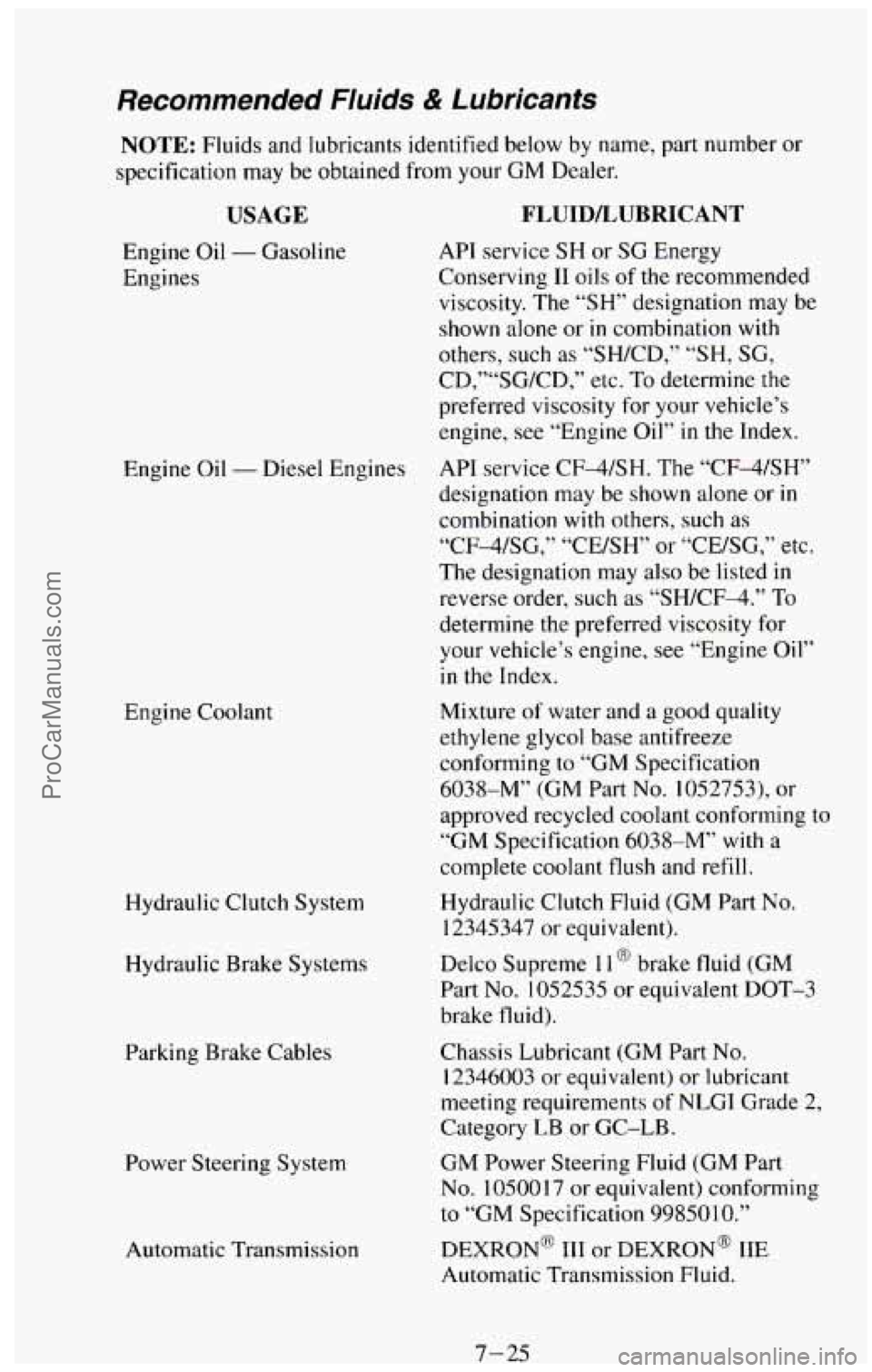
Recommended FIuids & Lubricants
NOTE: Fluids and lubricants identified below by name, part number or
specification may
be obtained from your GM Dealer.
USAGE
Engine Oil - Gasoline
Engines
Engine Oil
- Diesel Engines
Engine Coolant Hydraulic Clutch System
Hydraulic Brake Systems Parking Brake Cables
Power Steering System Automatic Transmission
FLUIDLUBRICANT
API service SH or SG Energy
Conserving
I1 oils of the recommended
viscosity. The
“SH” designation may be
shown alone or
in combination with
others, such as “SH/CD,”
“SH, SG,
CD,”“SG/CD,” etc. To determine the
preferred viscosity for your vehicle’s
engine, see “Engine Oil”
in the Index.
API service CF4SH. The “CF4SH”
designation may be shown alone or
in
combination with others, such as
“CF-4/SG,” “CE/SH” or “CE/SG,” etc.
The designation may also be listed
in
reverse order, such as “SH/CF-4.” To
determine the preferred viscosity for
your vehicle’s engine, see “Engine Oil”
in the Index.
Mixture
of water and a good quality
ethylene glycol base antifreeze
conforming to “GM Specification
6038-M” (GM Part
No. 1052753), or
approved recycled coolant conforming to
“GM Specification 6038-M” with a
complete coolant flush and refill.
Hydraulic Clutch Fluid
(GM Part No.
12345347 or equivalent).
Delco Supreme
11 @ brake fluid (GM
Part
No. 1052535 or equivalent DOT-3
brake fluid).
Chassis Lubricant (GM Part
No.
12346003 or equivalent) or lubricant
meeting requirements of
NLGI Grade 2,
Category LB or GC-LB.
GM
Power Steering Fluid (GM Part
No. 10500 17 or equivalent) conforming
to “GM Specification
99850 10.”
DEXRON~ TTI or DEXRON~ IIE
Automatic Transmission Fluid.
7-25 ProCarManuals.com